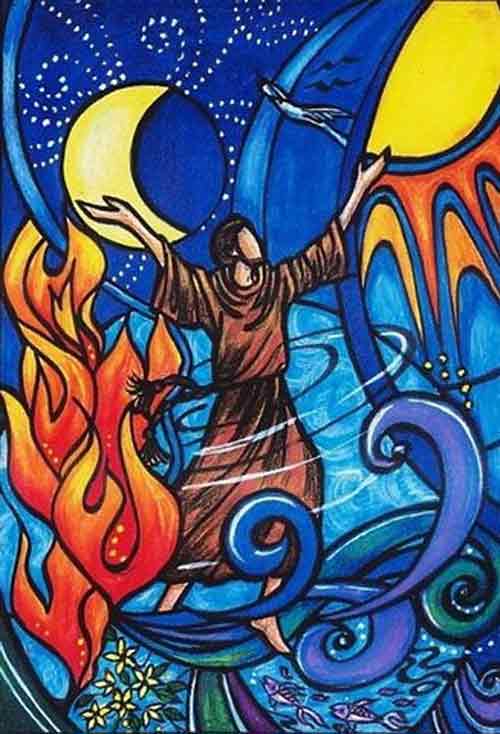In the month of September, and concluding on the feast of St Francis on October 4, many people focus on creation. This year the focus of Christians, and of people of goodwill, has been resourced by the encyclical of Pope Francis, Laudato Si’. For Christians, creation is not merely an academic discussion about evolution or not – it is now, much more, seen as an essential part of mission, in partnership with others who share concern for “our common home”.
This site is committed to the three year lectionary (RC) and its derivative, the Revised Common Lectionary (RCL). Rather than departing from that lectionary, in previous years resources have been provided on this site for a “creation reading” of our shared biblical texts. This means that this site has such creation reflections for Years C and A, and resources for this Creation Season for this year, Year B, will be added to that Creation Season resources page.
The lectionary for year B (2015, 2018, 2021…)
A creation reading of the lectionary for the Sunday between 4 and 10 September:
The Proverbs reading underscores that we are all creatures. Whether we claim more or less of creation, in fact none of us (but God) is over creation – we are all within it. In fact, our shared creature-hood is part of needing to treat other creatures equally, justly.
God’s mountains are a powerful metaphor for stability in Psalm 125.
The Isaiah reading has a number of images from creation, with a central focus on the importance of water.
Psalm 146 shows our connection to the earth, reinforces that it is God who made heaven and earth, the sea, and all that is in them, and also has a consequence on the responsibility to share.
Some of these threads are also woven into the text from the letter of James. Once again there is the acknowledgement of our duty to share and care within the creation God graciously gives.
The natural environment of Tyre, Sidon, the Sea of Galilee, and the region of the Decapolis form the frame for Mark’s story of a a Gentile woman, of Syrophoenician origin, to take on Jesus at his own craftsmanship of astute, witty repartee. Here, too, the question comes down to who can share in what of God’s natural provisions. The surprise in this text is that it is Jesus, for a change, who does not “win” this particular debate.
The additional value of using the agreed, shared texts of our three-year lectionary, rather than abandoning the lectionary to pick other, “convenient”, creation proof-texts using a concordance, is that by staying with the lectionary texts we demonstrate that creation is an integral thread woven through the whole Bible.
Please add, in the comments below, any further creation insights from the lectionary readings, as well as other creation resources that will be useful this month. Some of these ideas will be added to the Creation Season resource page which I encourage you to also check out.
If you appreciated this post, consider signing up for a not-very-often email, and/or like the liturgy facebook page…




A secular text is the last paragraph of the Origin of Species by Darwin with a lovely evocative picture of the natural world. Note this is from the 6th edition which added the words “by the Creator” This would go with a picture of a bank with flowers insects and birds
Enjoy and use it
Michael
It is interesting to contemplate a tangled bank, clothed with many plants of many kinds, with birds singing on the bushes, with various insects flitting about, and with worms crawling through the damp earth, and to reflect that these elaborately constructed forms, so different from each other, and dependent upon each other in so complex a manner, have all been produced by laws acting around us. These laws, taken in the largest sense, being Growth with Reproduction; Inheritance which is almost implied by reproduction; Variability from the indirect and direct action of the conditions of life and from use and disuse: a Ratio of Increase so high as to lead to a Struggle for Life, and as a consequence to Natural Selection, entailing Divergence of Character and the Extinction of less-improved forms. Thus, from the war of nature, from famine and death, the most exalted object which we are capable of conceiving, namely, the production of the higher animals, directly follows. There is grandeur in this view of life, with its several powers, having been originally breathed by the Creator into a few forms or into one; and that, whilst this planet has gone cycling on according to the fixed law of gravity, from so simple a beginning endless forms most beautiful and most wonderful have been, and are being evolved.
Thanks, Michael! A wonderful resource. Blessings.
Also a fine poem on God’s creation and our responsibility to it is God’s Grandeur. This blog contains the poem and some reflections on it
Michael
https://michaelroberts4004.wordpress.com/2014/08/26/gods-grandeur-gerard-manley-hopkins/
Hi there,
I came across this post when looking for artworks of the canticle of Creation. It’s a beautiful image, I just can’t see an acknowledgement of the artist? Could you please let me know who created it? Many thanks!
Thanks, Erin. I did a (click link) Google image search (as I expect you did too) – I cannot locate the artist, but as you see, it is found extensively. If you find out the artist, it would be great to acknowledge her/him here. So do let us know. Easter Season Greetings.